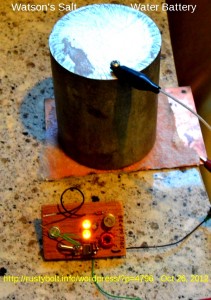I have this billet of magnesium that I’ve used for a number of things including a door stop. It’s rather light for its size, and the metal is soft, like aluminum. But the chips from drilling burn with a white light. It really is magnesium. I drilled a small hole in it to screw a screw in for a terminal to clip my clip lead on.
 The battery consists of the magnesium billet on top, two pieces of paper towel to hold the salt water “electrolyte” and prevent the plates from shorting, and on the bottom is a piece of printed circuit board, which serves as the copper plate.
The battery consists of the magnesium billet on top, two pieces of paper towel to hold the salt water “electrolyte” and prevent the plates from shorting, and on the bottom is a piece of printed circuit board, which serves as the copper plate.
I put the paper towels on the PC board, wet them with the salt water and set the magnesium on the paper towels. The two Joule thief LEDs lit up brightly for a second, but the brightness started to taper off over the period of a few tens of seconds. Open circuit voltage was 1.3 volts but fell to less than 0.6V with load.
The Joule thief uses a 2N525 germanium transistor (ETCO has long been out of business since the 1970s?) and two yellow LEDs in series. The voltage across these LEDs is greater than the voltage of a single LED such as white or blue, so if I connect an LED to the green and black wire leads, it will light brightly and the yellow LEDs will go out.
Later I got some lime slices and put the juice onto the paper towel. It seemed a bit brighter than the salt water, but I could not be sure without doing some measurements. Problem is that the current is constantly changing as the electrolyte gets used up. Here’s a cool battery lighting a LED.
Back to experimenting…